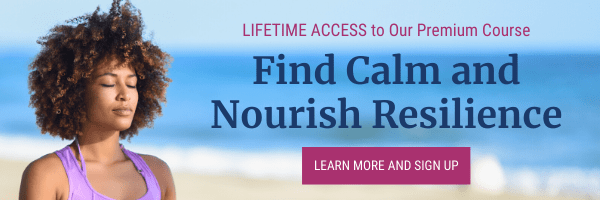Wherever you are, whatever your circumstances, we hope you are finding a way to plug into compassion, kindness, and care during these challenging days. In order to support everyone in our community and beyond, we’re gathering essential mindfulness resources for calm and resilience for everyone. Here’s how the Mindful community is coming together to serve in the days ahead so we can all tap into community, connection, and love.
Mindful@Home
Free Live Meditation Series
First, we’re kicking off Mindful@Home. Beginning Thursday, March 19th we’ll be serving live guided meditations on our social channels with experts in the field, including Sharon Salzberg, Mirabai Bush, Rhonda Magee, Bob Stahl, Elaine Smookler, Cara Bradley, Mitch Abblett, Mark Bertin, Barry Boyce, Anne Alexander, and more. Look for Mindful@Home meditations Mondays, Wednesdays, and Fridays at 3pm ET on our Facebook page. Watch all of the live videos we’ve served so far by clicking here.
Discounted Access to Our Premium Course:
Find Calm and Nourish Resilience
We’re also offering discounted access to our premium mindfulness course, Find Calm and Nourish Resilience.
We hope these expert-guided mindfulness resources can help you and your community find calm, navigate anxiety, and tap into a sense of well-being even as we all engage openly with the challenges of the day. Please freely share access to this premium course with your friends, family, colleagues, friends, followers, and networks.
This course features Zindel Segal on calming your mind, Jessica Morey on nourishing emotional resilience, Judson Brewer on training your brain to break unhealthy habits, Vinny Ferraro on cultivating compassion, Rhonda Magee on being conscious in community, Cara Bradley on mindful movement, and the Holistic Life Foundation crew, Andre Gonzalez, Atman Smith, and Ali Smith, on loving-kindness.
May this course provide a peaceful foundation for you and your community as we all navigate the days and weeks ahead.
Mindfulness Practices for Nourishment and Resilience
A few mindfulness practices to keep handy for the stressful and challenging days and weeks ahead.
The S.T.O.P Practice for Stress — from Elisha Goldstein
Creating space in the day to stop, come down from the worried mind, and get back into the present moment has been shown to be enormously helpful in mitigating the negative effects of our stress response. When we drop into the present, we’re more likely to gain perspective and see that we have the power to regulate our response to pressure.
Here’s a short practice you can weave into your day to step into that space between stimulus and response.
A Guided S.T.O.P. Practice for Stress
From Elisha Goldstein
S = Stop
Stop what you’re doing right now, get in a comfortable position, either seated or lying down.
T = Take
Take a few deep breaths. Maybe in through the nose initially, and then out through the mouth. With each exhalation allow your body to soften a bit more. As long as you’re here with the breath right now, allow your body to settle into its natural rhythm of breathing. Breathe in and sense the breath coming in. Breath out and sense the breath going out. Allow your body to take the breath it needs in its natural rhythm of being alive.
O = Observe
Begin to observe your body, noticing if there’s any tension or tightness anywhere, including the face. If you do notice any of that just allow it to soften, or just mindfully adjust your body as it feels like it needs to. Be aware of how you’re feeling emotionally right now. If there’s a sense of calm or ease, maybe some restlessness or irritation, or maybe even sadness. Or you could be feeling neutral. Whatever’s there, see if you can be aware of it and notice how it feels physically in the body. Continue to observe yourself physically and emotionally in this moment, just letting things be. Be aware of and observe your mind right now, noticing if it seems distracted or cluttered or if it seems like it’s settling into being here. Either way, it’s OK—the “o” of observe is just to allow us to be aware of our experience in the moment; physically, emotionally, and mentally. The moment we notice that our mind is off is a moment we’re present. Settle in, be aware of the fullness of your experience physically, emotionally, and mentally, and just let be.
P= Proceed
Proceed is just dropping the question of: “What’s most important for me to pay attention to right now?” or “What am I needing right now?” Allow whatever answer is there to simply percolate and arise. Proceed with that in this next moment. Always remember to acknowledge yourself for taking this time. This is a great act of self-care; take the final moment to acknowledge yourself for taking this time.
Feeling Isolated? Try this 20-minute Connection Practice — From Bob Stahl

The “web of life” meditation helps dissolve the illusion of that we are all separate by cultivating feelings of safety, compassion, and love. Over time, this practice will increase your feelings of connection not only to yourself, but also to your family, friends, work associates, and fellow living beings, the world around you, and the universe.
Guided Connection Meditation: “The Web of Life”
From Bob Stahl
This meditation will help you develop a deeper sense of connection—both to the present moment and those around you. Read through the entire script first to familiarize yourself with the practice, then do the practice, referring back to the text as needed and pausing briefly after each paragraph. Set aside about twenty minutes for this practice. Find a comfortable position on a cushion or chair or lying on a bed or the floor. Turn off your phone or other devices so you can remain undisturbed.
- Begin by checking in. Begin by taking a few moments to arrive and settle in by bringing your awareness into your mind and body. Acknowledge how you are feeling and let it be.
- Gently shift to mindful breathing, being aware of breathing in and out. There’s need to manipulate the breath in any way—just breathing in and out, normally and naturally.
- Shift attention to where you’re seated. Begin to feel the connection of your body on the chair, cushion, bed, or mat, and feel its connection to the floor. Reflect on the connection of the floor to the building you are in and its connection to the earth farther below.
- Let your awareness expand to include the earth below you. Feel that sense of being held by the earth below you, and just allow yourself to be held by the earth. You are in a safe space and you can breathe in and out with ease in your body and mind.
- Feel how the earth rises up to hold and embrace you. There is nothing more you need to do, nowhere you have to go, and no one you have to be. Just being held in the heart of kindness and letting be.
- Bring to mind someone you would hold this way. Reflect on your loved ones being held in the same way—with safety and ease of body and mind. Reflect on how the earth holds all beings, whether they are acquaintances, strangers, or difficult ones—with no bias, no discrimination, no separation.
- Reflect on how this earth holds all beings, forsaking none—whether they be small or large. Reflect on how this earth does not exist in a vacuum, that it is connected to a solar system and vast universe. We all are interconnected. Our bodies and the earth, the sun and the stars, are composed of the same matter—the same basic particles, joined in different ways. Feeling into that sense of connection and interconnection that we are all made of stardust. Feeling that sense of being home within your body and mind with a true sense of belonging and connection.
- Return your attention to the breath. Just breathing in and out, feeling the grace of this universe—no isolation nor separation, feeling that sense of connection and interconnection and being at home in your being. Nothing more you need to do, go, get, or push away. Imperfectly perfect as you are, resting in the heart of this universe.
- Let well-wishes form. May all beings here and everywhere dwell with peace.
Two Mindful Ways to Stop Touching Your Face
There are lots of goodsuggestions for limiting face-touching on the internet. Some common suggestions include “being mindful” or “taking a short pause.” Also, easier said than done. In that regard, a couple of small tips from the world of meditation may help.
- Don’t use a negative guideline or prompt (ha ha). Better: Use a positive guideline or prompt. When we teach meditation, we avoid suggesting to people what NOT to do, such as don’t have angry thoughts. It’s like saying to yourself, “Don’t think of an elephant?” What do you automatically fixate on? The elephant! When you say to yourself, “Don’t touch your face,” you’re focusing on the thing not to do. A positive prompt is to for example, ask yourself, “Are my hands below my neck?”
- Practice hand meditation. Number 2 follows from #1. Most instructions for sitting or walking meditation include instructions for where to have your hands, since our hands are such a critical aspect of how our body and mind engage the world. In these circumstances, when you’re out in the world and your hands may be compromised (obviously, best to keep washing and disinfecting), you may make your hands the focus of a light mindfulness practice. Instead of resting attention on the breath or your feet touching the ground (as you would in walking meditation), rest attention on your hands. You may find after trying this a few times, it can become an easier habit. For myself, I try to be aware of keeping them down at my sides when I’m not otherwise using them.







